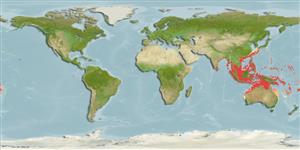>
Pleuronectiformes (Flatfishes) >
Bothidae (Lefteye flounders)
Etymology: Engyprosopon: Greek, eggys = nearly + Greek,prosopon = a face (Ref. 45335).
Eponymy: Dr C W F Mogk was a Surgeon Lieutenant Colonel in the Dutch East Indies, stationed in Samarang, North Celebes (1853). He discovered this species. (Ref. 128868), visit book page.
More on author: Bleeker.
Environment: milieu / climate zone / depth range / distribution range
Écologie
marin démersal; profondeur 2 - 189 m (Ref. 9824). Tropical
Indo-West Pacific: Indian Ocean, north to Taiwan to Malay Peninsula and Archipelago and the Coral Sea.
Taille / Poids / Âge
Maturity: Lm ? range ? - ? cm
Max length : 11.0 cm SL mâle / non sexé; (Ref. 9824)
Rayons mous dorsaux (Total) : 85 - 87; Rayons mous anaux: 63 - 67; Vertèbres: 34 - 35. This species is distinguished by the following characters: no concavity on head margin anterior to lower eye; gill rakers are very slender, long and not serrate; interorbital width narrow; no sexual dimorphism in coloration on blind side of body (Ref. 126076).
Description. D 85-87, A 63-67, pectoral-fin rays on ocular side 11-12 and on blind-side 8-9, caudal-fin rays 3 + 11 + 3, pelvic-fin rays on ocular-side 6, blind-side 6; lateral line scales 50-51; gill rakers 0 + 6-8; vertebrae 10 + 24-25 (Ref. 126076).
Life cycle and mating behavior
Maturité | Reproduction | Frai | Œufs | Fécondité | Larves
Hensley, D.A. and K. Amaoka, 2001. Bothidae. Lefteye flounders. p. 3799-3841. In K.E. Carpenter and V. Niem (eds.) FAO species identification guide for fishery purposes. The living marine resources of the Western Central Pacific. Vol. 6. Bony fishes part 4 (Labridae to Latimeriidae), estuarine crocodiles. FAO, Rome. (Ref. 9824)
Statut dans la liste rouge de l'IUCN (Ref. 130435: Version 2024-2)
Menace pour l'homme
Harmless
Utilisations par l'homme
Outils
Articles particuliers
Télécharger en XML
Sources Internet
Estimates based on models
Preferred temperature (Ref.
123201): 23.2 - 28.4, mean 27.4 °C (based on 737 cells).
Phylogenetic diversity index (Ref.
82804): PD
50 = 0.5000 [Uniqueness, from 0.5 = low to 2.0 = high].
Bayesian length-weight: a=0.00912 (0.00408 - 0.02036), b=3.04 (2.85 - 3.23), in cm total length, based on LWR estimates for this (Sub)family-body shape (Ref.
93245).
Niveau trophique (Ref.
69278): 3.5 ±0.4 se; based on size and trophs of closest relatives
Résilience (Ref.
120179): Milieu, temps minimum de doublement de population : 1,4 à 4,4 années (Preliminary K or Fecundity.).
Fishing Vulnerability (Ref.
59153): Low vulnerability (10 of 100).
